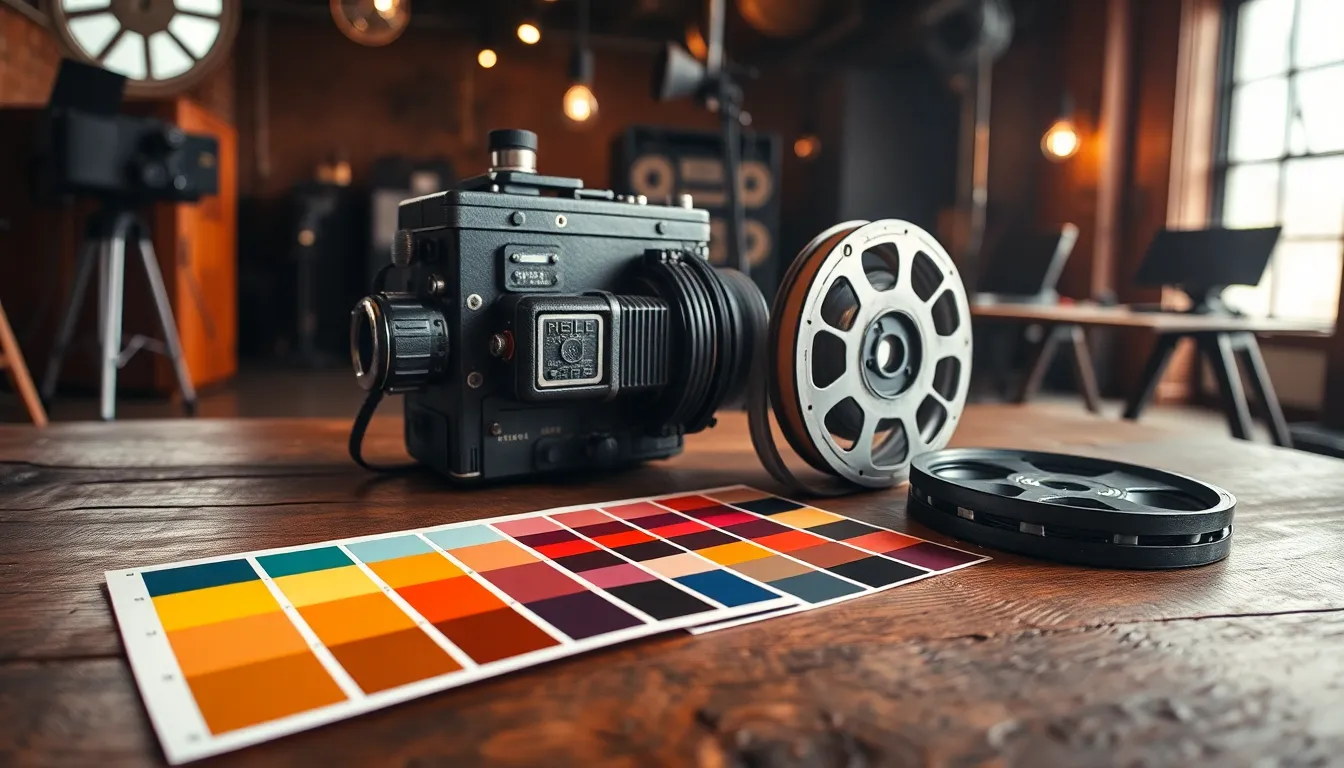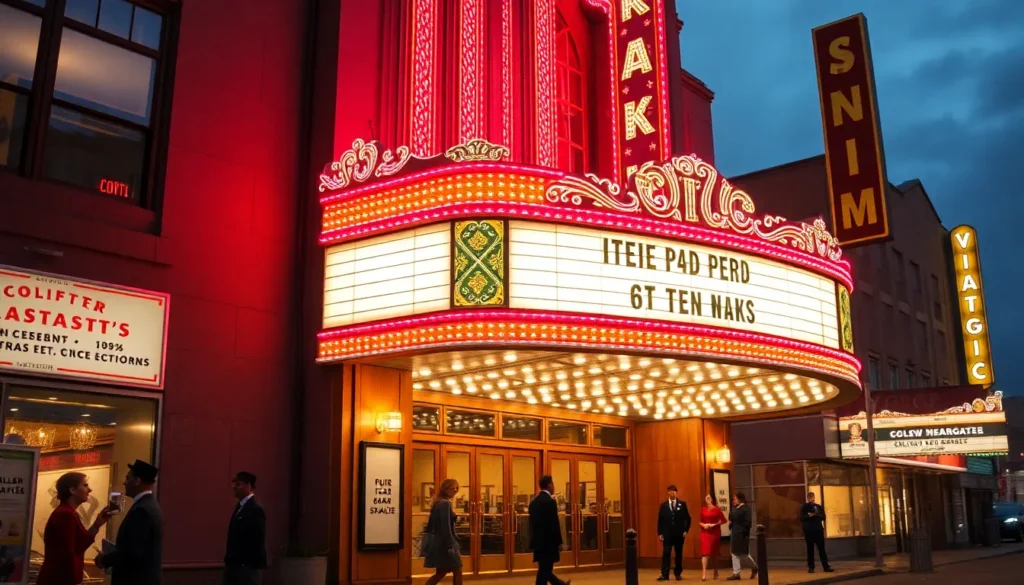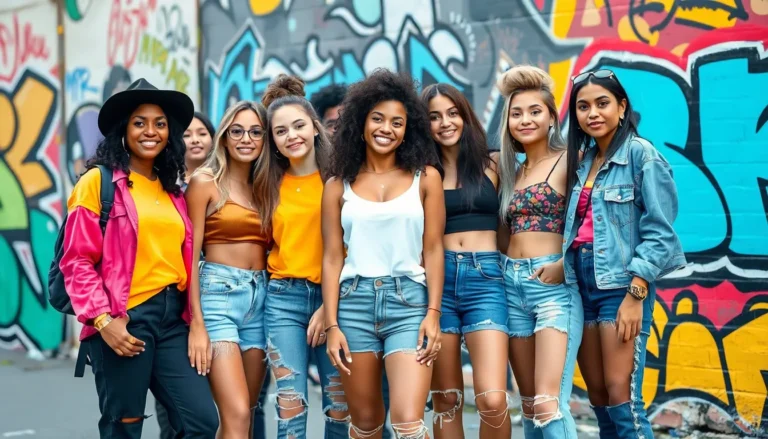Table of Contents
ToggleImagine a world where every film is in black and white, where vibrant reds and blues are merely figments of the imagination. For decades, audiences were captivated by the charm of monochrome, but the dawn of color films transformed the cinematic landscape forever. The journey from gray shades to dazzling hues is a tale filled with innovation, creativity, and a sprinkle of Hollywood magic.
The Evolution Of Color In Film
The journey from black and white to color film began in the early 20th century. Technicolor emerged as a significant advancement in film technology during the 1930s. By the time 1939 rolled around, major films like “The Wizard of Oz” and “Gone with the Wind” showcased the vibrant possibilities of color.
Two-color systems dominated the early stages. The process utilized red and green to create images, but it lacked the richness desired by filmmakers. Three-color processes introduced in the 1930s offered improved depth and vividness. With the invention of the three-strip Technicolor process, filmmakers could now present their vision more accurately.
Several technical advancements enabled this transformation. Cameras designed specifically for color film captured images differently than those for black and white. New dyes and chemicals increased color fidelity, allowing filmmakers to use color intentionally in story development. Various genres embraced color; musicals and romances thrived with vivid palettes.
Post World War II, filmmakers explored further innovations. Eastmancolor simplified production processes and made color filmmaking more accessible. Audiences responded positively, with many preferring color films over monochrome. By the 1960s, black and white films became increasingly rare as color became the standard.
Technical developments continued throughout the late 20th century. Digital technology emerged, allowing for color correction and enhanced visual effects. As a result, filmmakers could manipulate color in unprecedented ways, enriching narratives and audience experiences. The evolution of color in film has profoundly shaped the artistry seen on screen today.
Early Color Techniques

The transition to color in films involved several innovative techniques. Each method contributed uniquely to how audiences experienced cinema.
Stencil Coloring
Stencil coloring emerged in the early 1900s. This technique used stencils to selectively apply color to black and white film frames. Filmmakers created intricate designs to add layers of color, enhancing visual storytelling. Examples include the short film “The Bluebird,” showcasing vibrant color applications. Each frame received hand-applied hues, resulting in a labor-intensive but visually engaging process. The method, though time-consuming, allowed for creativity in color placement and expression.
Tinting And Toning
Tinting and toning offered filmmakers additional color options. Tinting involved dyeing the entire film stock with a single color, creating a specific mood. For instance, silent films often used blue tint for night scenes to evoke emotion. Toning, however, varied based on the chemicals used, imparting different hues to the film. This approach allowed directors to influence the audience’s emotional response effectively. Both techniques enhanced cinematic storytelling by adding depth and atmosphere to scenes.
The Rise Of Technicolor
Technicolor represented a game-changing moment in the film industry during the 1930s, opening the door to vibrant storytelling. Major productions showcased this innovation, captivating audiences and transforming cinematic visuals.
The First Technicolor Films
“The Toll of the Sea” (1922) marked Technicolor’s debut in feature films, utilizing two-color technology to bring color to life. “Becky Sharp” (1935) followed, becoming the first feature to embrace the three-color Technicolor process. A major milestone came with “The Wizard of Oz” (1939), which captivated viewers with its iconic use of color. “Gone with the Wind” (1939) achieved unprecedented success, solidifying Technicolor’s role in filmmaking. These early films demonstrated how color could enhance storytelling and engage audiences in new ways.
Impact On Filmmaking
Technicolor transformed the filmmaking landscape by providing filmmakers with tools to create rich visual narratives. Enhanced color palettes allowed for more expressive storytelling, enabling directors to influence audience emotions effectively. The detailed representation of settings and characters added depth to cinematic experiences. Filmmakers became more intentional with color usage in scene portrayal, incorporating thematic elements that resonated with viewers. As color films gained popularity, production methods evolved, pushing the industry towards embracing innovation and creativity. This shift planted the seeds for future advancements in visual storytelling.
Transition To Color In Mainstream Cinema
The shift to color in mainstream cinema marked a pivotal evolution in filmmaking, transforming storytelling techniques and audience engagement. This transition unfolded gradually through a series of significant developments.
Key Milestones
Technicolor’s introduction in the 1930s served as a major breakthrough, enabling filmmakers to incorporate vibrant color into their narratives. During this period, “Becky Sharp” emerged in 1935 as the first feature to utilize the three-color process. Subsequently, “The Wizard of Oz” and “Gone with the Wind,” both released in 1939, showcased how color could enhance emotional depth and visual storytelling. These milestones not only captured audiences but also pushed the film industry towards more ambitious projects.
Notable Color Films
Several films stand out for their groundbreaking use of color. “The Toll of the Sea” (1922) became the first Technicolor feature, impressing viewers with its visual appeal. “The Adventures of Robin Hood” (1938) also captivated audiences, employing Technicolor to create lush, vibrant environments. The visual creativity in “Fantasia” (1940) revolutionized animation, using color to bring classical music to life. Collectively, these notable films played crucial roles in shaping audience expectations for color in cinema.
Technological Advances And Color Film
Technological advances greatly influenced the transition from black and white films to color. Early color techniques like stencil coloring allowed filmmakers to apply color selectively, which enhanced visual storytelling in films such as “The Bluebird.” Stenciling laid the groundwork for more sophisticated methods.
Tinting and toning provided additional options for filmmakers. Tinting dyed film stock a single color, whereas toning used chemical processes to create varied hues. These techniques enriched scenes, influencing audience emotions and enhancing cinematic depth.
Technicolor emerged in the 1930s, marking a pivotal moment in film history. The debut of “The Toll of the Sea” in 1922 showcased two-color technology. In 1935, “Becky Sharp” became a standout example of the groundbreaking three-color process. Iconic films like “The Wizard of Oz” and “Gone with the Wind” released in 1939 further demonstrated how color could amplify storytelling and captivate audiences.
Production methods evolved alongside technological advancements. Directors embraced the creative possibilities that color offered, allowing them to invoke deeper emotional responses. Filmmakers utilized specialized cameras and new dyes to create visually stunning narratives. As color films surged in popularity, the film industry steadily adapted to new creative challenges.
Eastmancolor innovations after World War II made color filmmaking accessible. The technique simplified shooting and processing, encouraging more filmmakers to produce color films. By the 1960s, black and white films became an anomaly, clearly reflecting audience preferences.
During the late 20th century, digital technology added another layer of complexity. Enhanced color manipulation and visual effects transformed filmmaking again. Filmmakers leveraged these advancements to enrich narratives, engineer captivating visuals, and shape modern cinema’s artistry.
The journey from black and white to color in film represents a remarkable evolution that has profoundly shaped cinematic storytelling. This transformation not only enhanced visual appeal but also deepened emotional engagement, allowing filmmakers to craft richer narratives. As audiences embraced color films, the industry adapted and innovated, leading to a vibrant landscape of visual creativity. With advancements in technology and techniques, the art of filmmaking continues to evolve, proving that color is not just an aesthetic choice but an essential element of storytelling that resonates with viewers around the world.







